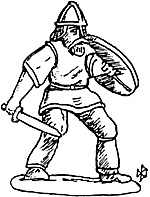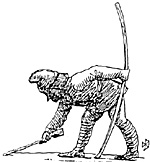 UNIT ORGANISATION
UNIT ORGANISATION
Each Unit made up of a number of stands (infantry 40 x 40 = 4 figs.) (Cavalry 50 x 50 = 2 figs)
Min 1 stand which includes the leader for that unit.
Leader has ability of 1 to 3 (fixed.)
Unit training / skill defined as Levy, Warband or Comitatus or Cavalry. This is fixed.
The motivation or spirit of a unit ranges from 1 to 10. This varies throughout the game.
Army or force consists of number of units, each led by a leader. The overall commander is on a normal stand and may join other units if necessary.
Usually no more than one third of force can be comitatus.
START OF GAME
All units start with no motivation score. (Scenario may alter this score). The commander throws 1D6 and adds 1 for each point of leader ability in his force, including himself. The total number of points is allocated to the units motivation.
TURN SEQUENCE
Turns are alternate
1. Leaders spend ability points on:
- a. Improving motivation
b. Manoeuvre
c. Ordering Charges
2. Movement
3. Shooting
4. Test units being charged
5. Melees
6. Panic Tests
 1. Leaders Actions
1. Leaders Actions
An army commander within 6 inches and not in melee can add his ability points to another unit.
a. Improving Motivation
If unit is not in melee, leader can spend his ability points on improving the Motivation.
b. Manoeuvre
If a unit has a Motivation of 10, it is forced to move toward the nearest enemy, the leader can spend a point on trying to hold.
A unit can stop or move straight forward at no cost. In order to change direction or formation, or move at the double, the leader must spend points on trying to influence.
A leader can also try and form shield wall (a single stand can form shield wall). Unit Motivation must be no less than 5 and no more than 9. Unit must be infantry in the open.
Roll 1D6 and score under;
- 3 Levy
4 Warband
5 Comitatus / Cavalry
c. Ordering Charges
Only possible for units with Motivation equal to or greater than 5.
To try and charge an enemy unit, leader must roll 1d10 and score under current Motivation.
- + leader ability score
-1 Unit is in cover (both units)
-2 target unit in shield wall
+1 Unit has second rank ("in depth")
Cavalry will not charge units in cover.
2. Movement
Compulsory Movers first:
- Units of Motivation 10 must move forward toward nearest enemy at least 2inches unless held.
Units of Motivation 2 to 4 cannot move forward or toward enemy
Units of Motivation 1 must retreat full move away from nearest enemy. (Rout)
Chargers move next, then all others. (All distances are in inches)
- Infantry normal move 4
Infantry Double Move 6
Infantry Charge Move 4+ 1dAv
Shield wall Max move 2
Cavalry 8
Cavalry Charge 8 + 1D6
Modify movement by terrain (half speed)
Chargers who fail to reach their target -1 Motivation
 3. Shooting and Skirmishers
3. Shooting and Skirmishers
No separate units of skirmishers. A unit may have individually based skirmishers attached to it. Max of 1 per stand. They do not make contact but rely upon missile fire.
Position within 6 inches of parent unit and move up to 6 inches in movement phase. They will always evade chargers.
As a stand is removed, remove 1 skirmisher fig too.
In the shooting phase, if the parent unit is not in melee, they may shoot at enemy units in the open within 12 inches.
For each fig shooting, roll 1D6. Hit on 6 Shieldwall, Skirmishers or Cavalry save on d6 roll of 5, 6.
The removal of skirmisher figs does not count towards unit casualties.
4. Test units being charged
See Panic tests for method.
If a unit being charged routs and is contacted by charger, it is automatically destroyed in the melee phase. Cavalry can evade an infantry charge (even if they moved) up to 8inches. They suffer -1 Motivation
5. Melee
Only possible if a unit has successfully charged.
Line up stands and count. Max one stand per unit as an overlap
Both sides roll 1D6 and modify;
- For each stand of Levy in contact +1
For each stand of Warband +2
For each stand of Comitatus/Cav +3
Each stand in Shield wall +1
Chargers, each supporting stand +1 (second rank of stands)
Infantry charging, each stand +1
Cavalry charging, each stand +2
Compare totals. Highest score wins melee.
The loser takes hits in figures equal to the difference in scores and -1 Motivation
If difference is >= 4, winner also takes 1 hit point (fig), loser an additonal -1 Motivation and Shield walls are broken. (This rule is cumulative for each 4 points)
Casualties
Casualties are only removed as whole stands, remainder carried forward. Stands may be removed from rear ranks first. Count cavalry figures as two figs. (ie 4 hits per stand)
Leaders as casualties
Leaders stands can normally be removed last. However, when a stand is removed, roll 1D6. If score = 6, leader stand is removed
End of melees
If a unit has reached Motivation 1, it will rout immediately, moving full move to rear. (See Panic tests) Winning unit can move forward 1 stand from rear ranks to contact. Cavalry with higher Motivation than opponent may voluntarily break off, retreat full move and suffer -1 Motivation.
6. Panic Tests
Taken when;
- Unit is charged
Unit loses a stand
Commander lost within 12inches
Cavalry charged by infantry lose melee
Roll 1d10 and modify:
- +/- Motivation
+1 Uphill
+2 Shield wall or defending obstacle
-1 each stand lost this turn
-2 Flank attacked
-3 Rear attacked
-2 Unit leader killed this turn
Score 5 to 10 = -1 Motivation
Score < 5 = -2 Motivation. If in melee, break off and retreat full turn.
If Motivation reaches 1 unit routs immediately, full move distance to rear.
A unit whose opponent in melee beaks, routs or is destroyed adds +1 to Motivation
Additional +1 if enemy higher grade.
A unit in Shieldwall that has its Motivation reduced to below 5 does not automatically lose it's shieldwall formation.
OPTIONAL RULES
Berserkers
Once the battle lines have been set out, Roll 1D6 per Levy / Warband unit.
Odds = Berserker.
These individually charge the closest enemy unit. Roll 1D6. 5,6 = hit (6 on Shieldwall). For each hit, roll again until no hits. Berserker then removed.
If two opposing berserkers meet, simply roll d6, highest wins, loser killed.
Druids / Shamen
Attached to a unit. Do not contact any other troops but are removed when leader stand is removed. Has an ability of 1 to 3 which can be used to add to leader ability or as general, to others within 6 inches. Can also be used to curse enemy leaders within 6 inches, removing Motivation in the same way.
| 1 | 2 | 3 | 4 | 5 | 6 | 7 | 8 | 9 | 10 |
|---|---|---|---|---|---|---|---|---|---|
| ROUT | NO ADVANCE | NO ADVANCE | NO ADVANCE | SHIELDWALL (SW) | SW | SW | SW | SW | MUST ADVANCE |
Back to Table of Contents -- Lone Warrior #137
Back to Lone Warrior List of Issues
Back to MagWeb Magazine List
© Copyright 2002 by Solo Wargamers Association.
This article appears in MagWeb (Magazine Web) on the Internet World Wide Web.
Other military history articles and gaming articles are available at http://www.magweb.com
